swooshdave
Jul 13 2014, 06:28 PM
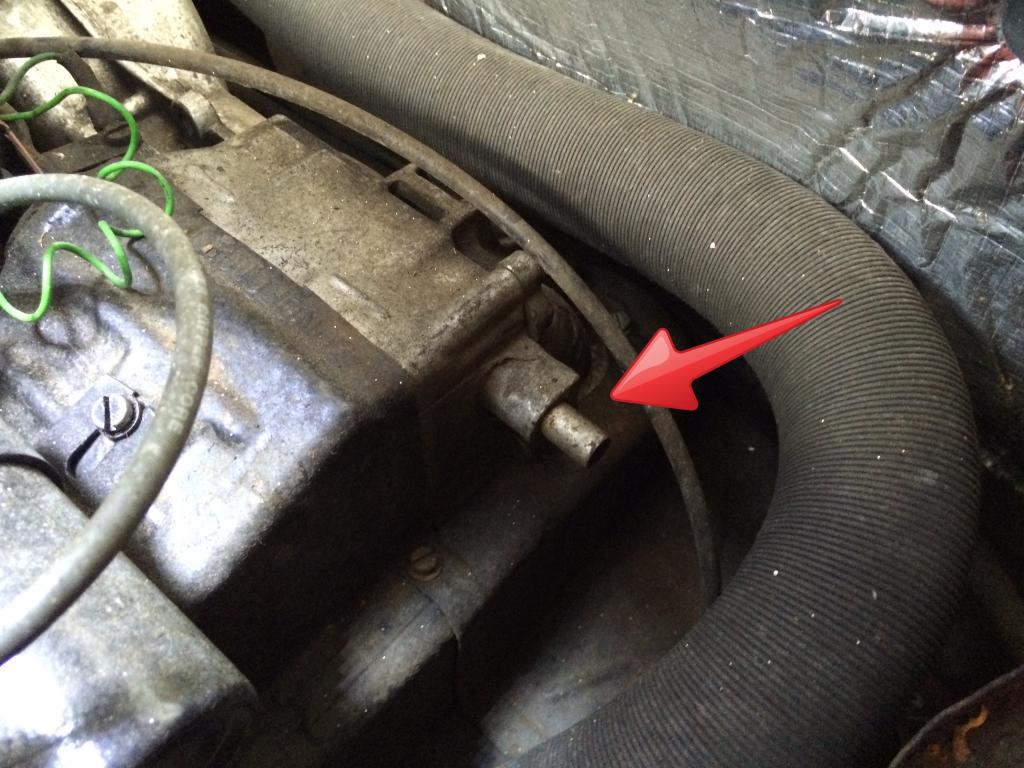
Passenger side, front of the engine. Don't know what this does. Should it be blocked off?
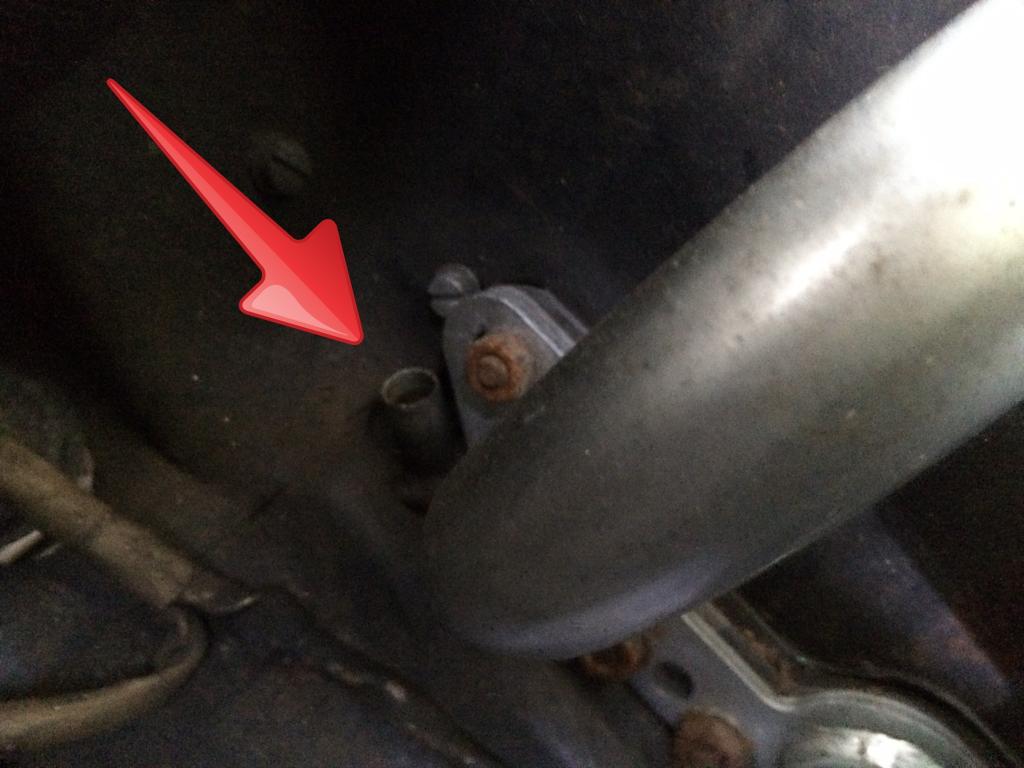
Both sides there are two ports that are open. They are ahead of the intake manifold. Should they be blocked off?
Car has single carb.
ClayPerrine
Jul 13 2014, 07:10 PM
The two on the heads should run to a flash suppressor mounted next to the air flap rod retainer on the left side of the engine. That should have a hose running to the air cleaner. What you have is going to let oil out of the motor under hard cornering and make a mess, and it allows dirty air and water into the insides of the motor.
The other one is just air from the fan. It won't hurt anything to leave it open.
Dave_Darling
Jul 13 2014, 07:11 PM
The first one shown pushes air into the fuel vapor recovery system. It collects fuel vapor from the fuel tank, and routes it into the intake of the fuel injection system to be burned.
The second one is part of the positive crankcase ventilation system. It takes oil vapor and routes it into the intake to be burned.
With a carb'ed car, you need to figure out how you want to deal with those systems. I personally would try to keep them intact--but then, I wouldn't put a single-carb setup on the car in the first place.
--DD
Cap'n Krusty
Jul 13 2014, 07:23 PM
If you disable the vapor recovery system, you'll soon be asking us how to get rid of the fuel smell in the cockpit ................................ You won't be the first.
The Cap'n
swooshdave
Jul 13 2014, 07:38 PM
To be clear I did not put the single carb on the car. It came that way. I hope to go back to FI at some point.
So there is a hose that goes all the way from the vapor recovery tank to in the front to the engine? Where does it come out of the vapor tank? Where does the hose run?
Can I just run a hose from one side of the manifold to the other for now?
zambezi
Jul 13 2014, 08:47 PM
charcoal canister hoses run down the drivers side behind the rocker covers. If you run one hose from one head to the other, you will block off the holes but at the same time not allowing the engine oil vapors to breath and you can start building crankcase pressure. That can lead to oil leaks.
swooshdave
Jul 13 2014, 09:44 PM
QUOTE(zambezi @ Jul 13 2014, 07:47 PM)

charcoal canister hoses run down the drivers side behind the rocker covers. If you run one hose from one head to the other, you will block off the holes but at the same time not allowing the engine oil vapors to breath and you can start building crankcase pressure. That can lead to oil leaks.
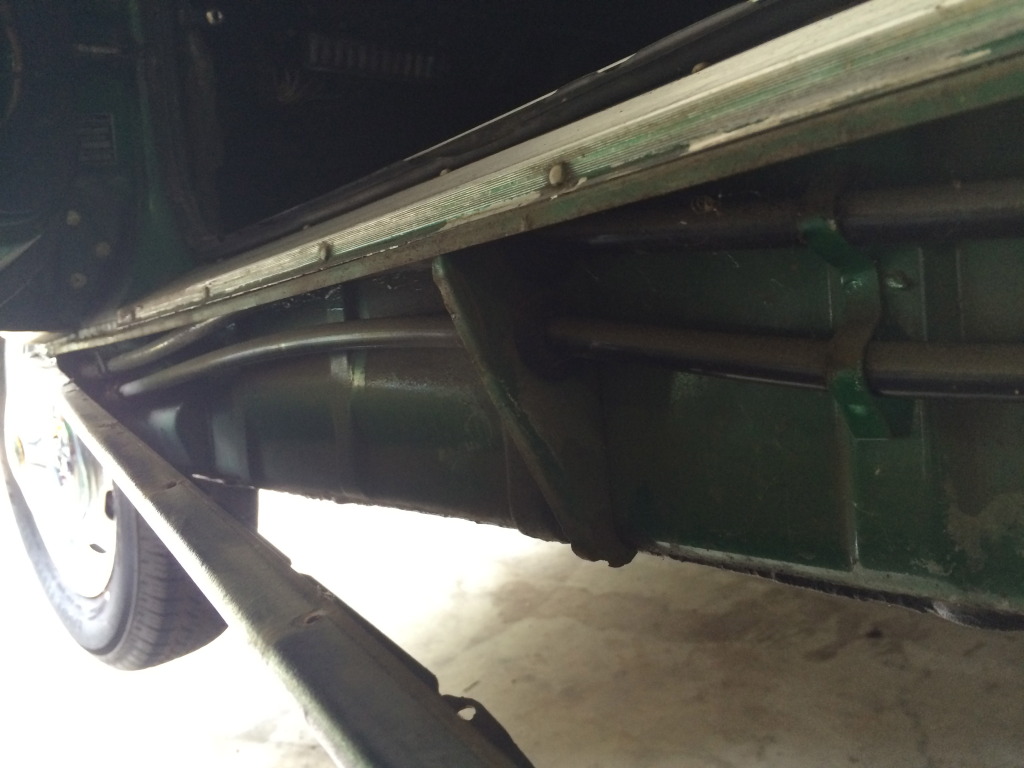
So these. Is one a send and the other a return? Or one for each head? Where do they come into the engine bay?
"Engine oil vapors" are technically blow-by past the rings. It's a serious issue on smaller displacement engines (especially parallel twins) with poor breathing. But they usually breath out the crankcase and not the heads. You can get some real benefits by putting reed valve breather on a crankcase (not as much on a 4 cylinder).
type47
Jul 14 2014, 04:46 AM
ClayPerrine
Jul 14 2014, 05:31 AM
QUOTE(swooshdave @ Jul 13 2014, 10:44 PM)

QUOTE(zambezi @ Jul 13 2014, 07:47 PM)

charcoal canister hoses run down the drivers side behind the rocker covers. If you run one hose from one head to the other, you will block off the holes but at the same time not allowing the engine oil vapors to breath and you can start building crankcase pressure. That can lead to oil leaks.

So these. Is one a send and the other a return? Or one for each head? Where do they come into the engine bay?
"Engine oil vapors" are technically blow-by past the rings. It's a serious issue on smaller displacement engines (especially parallel twins) with poor breathing. But they usually breath out the crankcase and not the heads. You can get some real benefits by putting reed valve breather on a crankcase (not as much on a 4 cylinder).
You are confusing the two systems. The lines running down the rockers connect to the charcoal canister. That collects the gasoline vapors from the tank and the fan feeds air into the canister to blow the vapors into the air cleaner where it is burned with the intake air.
The lines from the head are crankcase vents. They connect together and get hooked to the air cleaner. They provide air intake for the PCV valve. The valve pulls the blowby in the crankcase into the intake where it is burned with the intake air.
swooshdave
Jul 14 2014, 07:58 AM
QUOTE(ClayPerrine @ Jul 14 2014, 04:31 AM)

You are confusing the two systems. The lines running down the rockers connect to the charcoal canister. That collects the gasoline vapors from the tank and the fan feeds air into the canister to blow the vapors into the air cleaner where it is burned with the intake air.
The lines from the head are crankcase vents. They connect together and get hooked to the air cleaner. They provide air intake for the PCV valve. The valve pulls the blowby in the crankcase into the intake where it is burned with the intake air.
Looking at the diagram and because I'm lacking the air cleaner you can see that it would be easy to get confused.

So the anti-flashback valve = PCV?
boxsterfan
Jul 14 2014, 08:25 AM
No, PCV is next to the "OEL" ("OIL" for us in the USA). Flashback valve is to the left of that.
swooshdave
Jul 14 2014, 08:40 AM
QUOTE(boxsterfan @ Jul 14 2014, 07:25 AM)

No, PCV is next to the "OEL" ("OIL" for us in the USA). Flashback valve is to the left of that.
And it's not called out on the above diagrams?
boxsterfan
Jul 14 2014, 09:32 AM
No, it's not called out. But PCV valve is at 5 o'clock (maybe 4 o'clock) position to "OEL".
barefoot
Jul 14 2014, 10:55 AM
QUOTE(swooshdave @ Jul 13 2014, 08:28 PM)


Both sides there are two ports that are open. They are ahead of the intake manifold. Should they be blocked off?
I plan on running these 2 rocker cavity vents to an oil catch container which also drains back to the port next to the oil fill cap. Can then vented to dual carb air cleaners. Boy, that's 5 hoses just to vent oil fumes.
Note that earlier heads don't have these end tubes, how did they vent the rocker cavities ?
For you FI guys, sure glad there are color pictures showing hose routings, that's complicated
Barefoot
ClayPerrine
Jul 14 2014, 10:57 AM
The only engines that don't have the vent tubes in the heads are the 1.8L engines. They use a different system to vent the crankcase pressure.
swooshdave
Jul 14 2014, 10:49 PM
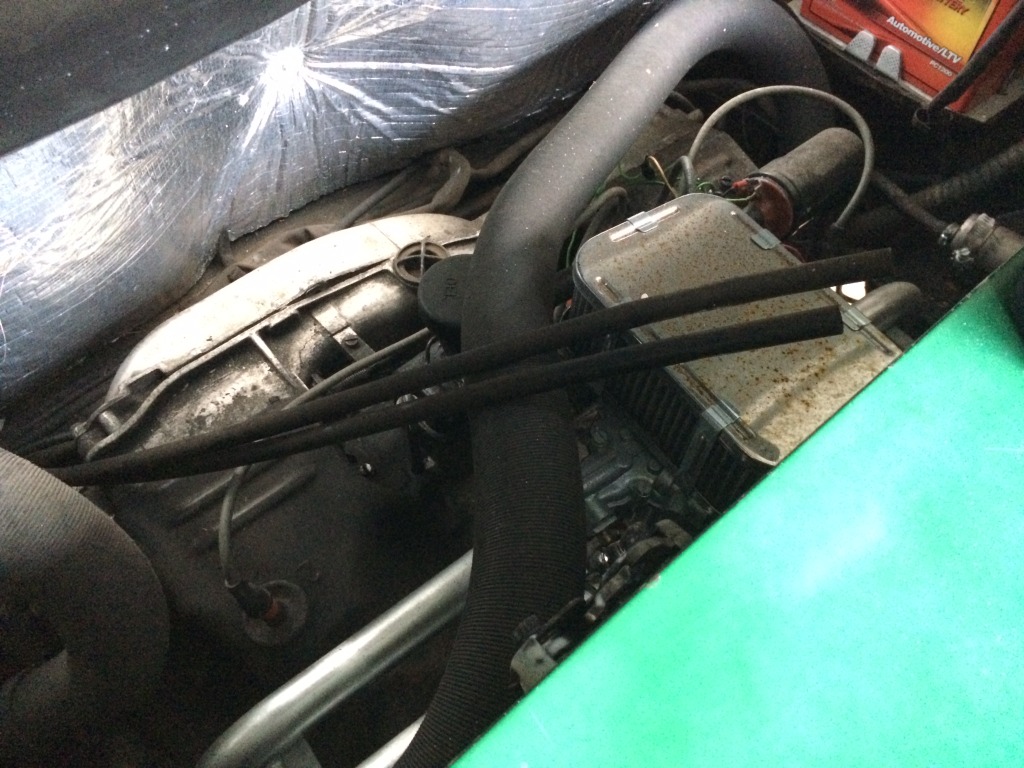
I found these two hoses sitting in front of the engine. They appear to be plastic. I assume these are the tank vapor system?
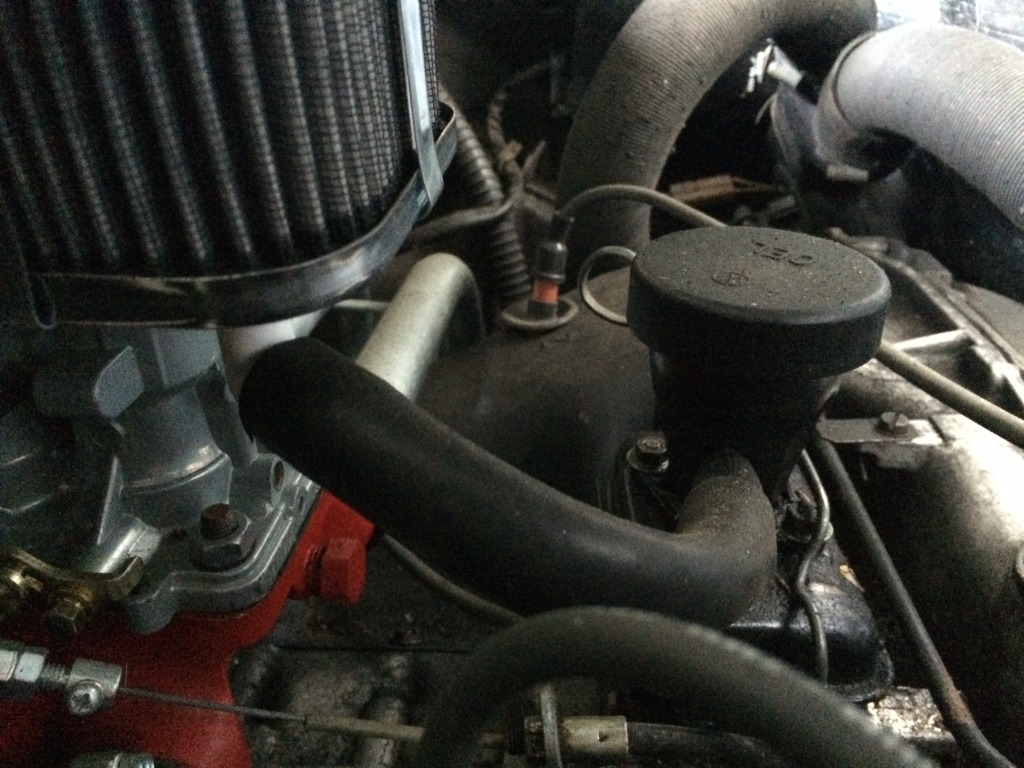
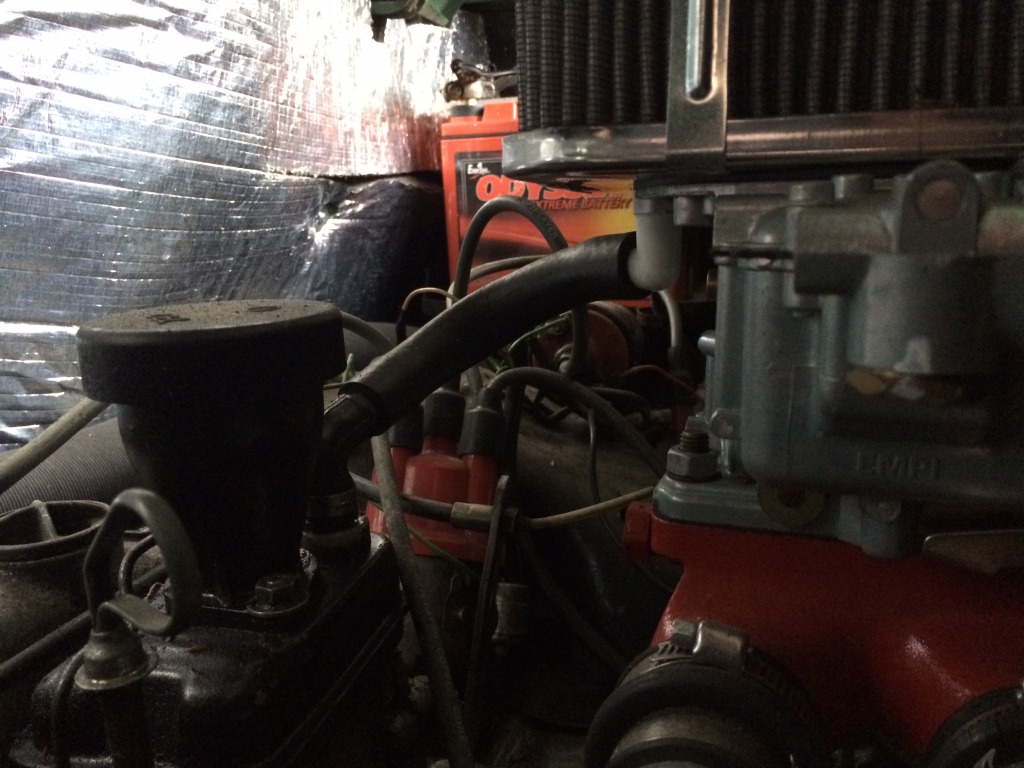
I also looked closer for a PCV valve. I could this hose coming out next to the oil filler and going to the carb. Is this it?
TheCabinetmaker
Jul 15 2014, 05:07 AM
QUOTE(ClayPerrine @ Jul 14 2014, 11:57 AM)

The only engines that don't have the vent tubes in the heads are the 1.8L engines. They use a different system to vent the crankcase pressure.
And the 75/76 2L
ClayPerrine
Jul 15 2014, 05:53 AM
QUOTE(swooshdave @ Jul 14 2014, 11:49 PM)


I found these two hoses sitting in front of the engine. They appear to be plastic. I assume these are the tank vapor system?


I also looked closer for a PCV valve. I could this hose coming out next to the oil filler and going to the carb. Is this it?
Yes, but it won't work right connected there. It needs to be connected to manifold vacuum.
The hoses in the front of the motor are for the Charcoal canister. Connect one to the fan port on the right front corner of the motor, and the other to the air cleaner.
swooshdave
Jul 15 2014, 10:39 PM
QUOTE(ClayPerrine @ Jul 15 2014, 04:53 AM)

Yes, but it won't work right connected there. It needs to be connected to manifold vacuum.
The hoses in the front of the motor are for the Charcoal canister. Connect one to the fan port on the right front corner of the motor, and the other to the air cleaner.
What is the difference between intake vacuum and manifold vacuum?
This is a "lo-fi" version of our main content. To view the full version with more information, formatting and images, please
click here.












